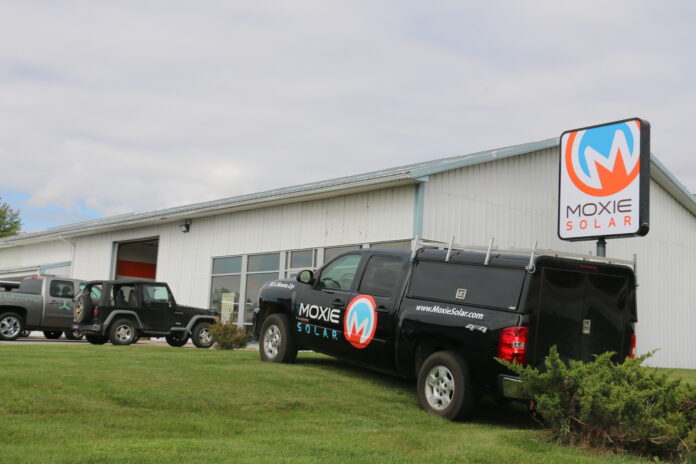
In a December 2019 interview with the CBJ, Moxie Solar CEO Jason Hall said he anticipated at least $30 million in revenue the following calendar year, so why did one of the country’s most promising solar companies go out of business just three years later?
Many factors were at play, and answers vary, but one central theme kept arising when asking former employees of their thoughts: The company expanded too much and too quickly. And then it was too late.
“The biggest issue they had, frankly, was they tried to grow too fast,” said Keith Fuglaar, Moxie’s CFO during the company’s final months.
The company’s strong financial position evaporated — coinciding with the COVID-19 pandemic and global supply chain woes — leaving Moxie in an untenable relationship with financial holding companies and third-party installation crews, even after an out-of-state investment group called Lorentzen Investments acquired the company and assumed total control of operations in September 2022.
Once Moxie factored in efforts to sell used EV vehicles, construct a solar panel manufacturing facility and build an upscale, mixed-used entertainment district in North Liberty, the business was unable to keep up with all its efforts.
To recap previous stories, check out this overview of the situation.
Bright start
Jason Hall began his career in the banking industry, working nine years as a relationship manager with Firstar, now known as US Bank, before leading the founding of an Iowa City location of First American Bank.
He left to join what was then Family Merchants Bank in Cedar Rapids, serving as president and CEO, and then becoming CEO of TMone.
But in 2008 he also founded Greenhall Industries, where he would run energy efficiency audits for customers.
By 2012, Mr. Hall noticed an opportunity. Iowa state lawmakers had just approved a solar income tax credit that would match more than half of federal credits, in addition to the federal tax credit program that already covered approximately 30% of solar project costs.
“[State tax credits] really stepped up in a big way when it came to solar,” said Julian Vandervelde, a former vice president of sales for Moxie and a University of Iowa and NFL offensive lineman.
The combination of experts on the ground and a business climate ripe for ambitious companies allowed Moxie to explode onto the scene. From 2013-15, Moxie saw revenues grow by 536%. In 2016, 80% of its clients were still based in the Corridor and the company had grown to 30 employees.
“We’ll see a 60% drop in the overall cost of solar over that period of time, whereas the incentives only add up to 45% today,” Mr. Hall told the CBJ in 2016 about the projected cost decrease of photovoltaics. “So unless something unforeseen happens – which you always try to do your best to plan for – we are very bullish on solar and the future of what solar is going to do.”
Illinois passed its Future Energy Jobs Act in 2017, marking another milestone in the company’s history. The bill required utility providers to source 25% of electric generation from renewable energy.
“Every solar developer in the country wanted to start working in Illinois,” said North Liberty Mayor Chris Hoffman.
Mr. Hall moved swiftly to open another headquarters in Dixon, Illinois, by April 2018, announcing plans to employ 50 within 36 months.
“Illinois had the most lucrative state level solar incentive in the history of the country to my knowledge for two and a half years,” said Mr. Vandervelde. “And that was massive for our expansion, because between the solar tax credit, and then the state tax credit in Illinois, homeowners could get solar for 50 cents on the dollar. At one point in time, we were bidding projects to farmers in Illinois where the cost was a net negative.”
One year later, Moxie was still growing at an exponential rate, achieving a growth rate of 270% from the previous year. They operated in about six states and had 80 employees in April, expecting to reach 100 by June.
“What really kept us rolling was this vision, this dream that we had of being a company that was going to change the world and put Iowa on the map,” said Mr. Vandervelde.

“We were a very capable, very unique, very diverse group of people that genuinely cared about that company and genuinely cared about the mission,” said Brandi Webster, an executive assistant for Moxie.
While the Iowa state tax credit recently expired, the federal tax credit was extended for 10 years, though Iowa Solar Energy Trade Association President Lewis Butler notes the policy swings make it difficult to ride the “solarcoaster.”
Despite the company going out of business, the early years of Moxie and the promise of renewable energy left a legacy that impacted solar for future generations.
“So much of the policy on solar in Iowa is because of conversations that he [Mr. Hall] and I and others in the industry had nine years ago,” said Mr. Hoffman. “There weren’t rules necessarily on zoning or setbacks in cities or counties.”
Expansion explosion
The COVID-19 pandemic struck in March 2020. At the time, Moxie was a top rated solar company. While many solar companies closed their doors because they operated under an in-the-home sales model, Moxie was ahead of the curve and thrived.
“We were starting to consider a digital platform [for sales] in late 2019,” said Mr. Vandervelde. “We transitioned our entire sales staff over…we realized we can sell to anybody, anywhere using our same sales platform because our process was a well-oiled machine. The sales aspect was easy.”
Moxie also accepted a $1.16M Paycheck Protection Program (PPP) loan in April that was entirely forgiven. The business said the money went entirely to payroll and would help 119 employees, as reported by ProPublica.
Consumers stuck at home around the country bought into Moxie’s vision. Moxie expanded rapidly from a handful of states to 13 and finally 26 total states at its peak.
“We were trying to catch something that seemed untouchable,” he continued. “There’s a giant that is climate change. If we have the opportunity to … really chase this thing down, we have to take it.
“Sometimes your eyes get a little too big for your stomach.”
What was once a carefully measured decision on whether to expand to a new state suddenly became less so.
As the number of sales increased, Mr. Hall’s “inhibition kind of went away,” said Mr. Hoffman. “That made it easier to move into all of these other states…because they will just ‘figure it out.’”
It appears members of Moxie’s leadership team, similar to a lot of businesses, wanted the company to be as big as possible.
“I want to help grow Moxie to be a true national company,” said COO Travis Eichelberger in a CBJ publication in October 2020. “We currently operate in 14 states. I want to be operational in 48.”

“I think the other thing that happened is that there was a lot of easy money coming into the industry,” said Mr. Fuglaar. “Finance companies were very eager to get in on this trend as well. They made it very easy for consumers to borrow and easy for companies to get advances on these projects.
“Moxie would get money to do the project and they would do part of the project and either run out of materials or run into scheduling problems,” he continued. “Rather than finish [that project], they would just move to the next sale, get another advance and so on.”
Moxie went through a number of local and national companies when securing the best terms for their projects.
“I think every company probably has slightly different standards of when payment gets triggered and how much documentation there is around that system being operational,” said ISETA President Lewis Butler.
In approximately 2019, Moxie took advantage of GreenState Credit Union’s merchant lending program.
“Our unique advantage was that we could offer their customers a lower rate than most other large national banks in this space,” said GreenState’s chief marketing officer Jim Kelly in an email. “After a few years, we found that we didn’t have what it took to compete in this arena and we stopped offering merchant lending altogether. So we closed out all our business relationships.”
Once GreenState stepped aside, Moxie began utilizing terms set by national companies like Sunlight Financial and SunPower.
The permitting and licensing process in new states also took months longer than normal because of COVID-19 closing government offices, said Mr. Eichelberger. He also mentioned the slowdowns caused by supply chain woes, particularly how business slowed when tariffs were enacted or when Tesla Powerwalls weren’t shipped on time.
Bram Williams first saw warning signs in the fall of 2020. He was hired as the initial candidate for Moxie’s Magnet Executive Leadership Program, a position that allowed him to see inside each department at the company.
“I was the only person [outside of leadership] at Moxie that got to do a little bit of permitting, a little bit of engineering, saw a little bit of the sales side and worked side-by-side with the managers,” he said. “They were farming out construction projects to contractors.”
“Moxie prided itself on the rapid response team,” he added, saying Moxie emphasized fast turnaround on quality project plans.
Over the years, Moxie excelled when they used their own installation crews on solar projects. As they expanded throughout the nation, they were forced to rely on third-party installation crews at a time when the number of new projects was growing by the day.
“When Moxie controlled things, we were firing on all cylinders,” said Mr. Vandervelde, noting subcontractors had other priorities and processes. “When that control was taken away and put into somebody else’s hands, there we started to have problems.”
A Facebook group of aggrieved Moxie customers say they aren’t the only people so far unable to recover money from Moxie for unfinished projects, with posts indicating some construction companies never received payment for their services.
“There are tons of subcontractors that have liens on people’s houses and there’s vendors that are saying they weren’t paid,” said Cody Leclere, a former lead engineer, permitting and interconnection specialist for Moxie. “We could not get certain solar modules and then we would have to resubmit for interconnection and permits all over again.”
Mr. Fuglaar confirmed new ownership had to walk away from some third-party installers because there was no money left to go around.
Several lawsuits are currently going through the Iowa court systems from suppliers alleging Moxie breached their contract and did not pay for materials they had owed.
A former market president in Peoria, Illinois, alleged in a 2022 petition that she was underpaid commission she earned on a major project, as well as not receiving payment for jobs in progress at the time of her termination, despite claiming she was owed the commission per her agreement with Moxie.
For all of Moxie’s headaches in its later years, the problems boiled down to a cash flow issue. Despite selling installation jobs across 26 states, they only had their own crews in North Liberty, Dixon, Illinois, and a few other states. When you outsource these jobs, a few things happen, said Mr. Fuglaar.
“Prices go up because you’re paying someone else to do it, not your own people” he explained. “Your ability to handle changes in schedule, and your ability to control quality goes out the window. They were running into a lot of issues…that created ill will and lawsuits.
“The better way [to expand] would’ve been to continue to grow in this area and steadily move into surrounding areas,” he added. “It was just not a good solid business plan.”
By late 2021, Moxie laid off the majority of the sales team in its first round of layoffs, realizing it had been selling too effectively and not wanting to sell more. The company scaled back operations in other states but still had many ongoing projects it needed to finish.
“You could tell who was fired because the [Salesforce] password changed,” and a new password would be sent to the company, said Mr. Williams. Salesforce is a popular customer relationship management (CRM) platform.
Other ventures take focus
As well as learning from senior management, Mr. Williams said he was brought into the company to help spearhead VERV EV, a used electric vehicle dealership Moxie launched in North Liberty in February 2020.
VERV EV was the most recognizable sub-brand of Moxie Solar and the first ever used EV car dealership in Iowa. It sold Chevrolet Sparks, Teslas and Mitsubishi Outlanders.

Launching VERV was a striking shift away from the company’s roots of just installing solar panels; instead, Mr. Hall wanted to adopt a vertical integration approach that would keep customers within the Moxie ecosystem.
“It’s such a natural counterpart, so we believe the future is to sell the electric vehicle and the solar system as one,” VERV executive vice president Leah Furnish told the CBJ in 2020.
The shift began in April 2019 when Moxie rebranded to MOXIE – America’s Solar Company and announced itself onto the national scene by unveiling a new logo.
At the same time VERV began operations, Moxie hired former Iowa City Area Development Group (ICAD) president Mark Nolte to lead efforts in constructing a $10 million solar manufacturing facility.
Moxie’s goal was to import the modules, components and solar cells to assemble at the plant before selling to the open market.
Manufacturing solar panels is, to put it simply, complicated. The selected plant must be a ludicrously precise facility that is airtight, clean and the temperature must be set just right, said Mr. Vandervelde.
“We do not have the physical proximity to a lot of the raw materials that you need,” he said. “It’s a meticulous process. Just to start it, you have to put in…some seven figure numbers worth of materials just to get your first batch of actual cells out. Then they have to pass all the regulations and certifications to be legally used on a roof.”
Even if Moxie made it this far, the panels were likely to cost much more than the panels bought from overseas, said Mr. Williams.
So while the prospect of manufacturing solar panels was enticing, there still existed a harsh financial reality.
“The source of capital will be the largest challenge in how to do this,” said Mr. Hall in 2019. “It’s about being smart about how we structure the company, fund it and market it.
“We have a good business model right now, and I don’t have a problem with demand, which is the key piece,” he added. “The rest of the details – I don’t want to say they figure themselves out, but when you really lose sleep is when you start manufacturing and can’t sell it for a profit.”
Mr. Nolte only remained in the role for four months and did not respond to interview requests. Efforts to finally sell solar panels never materialized.
Johnson County was a leading candidate for the site of the manufacturing facility, partly because of Mr. Hall’s appreciation for the area.
“I derive a significant amount of pride in what we accomplish in North Liberty,” said Mr. Hall in 2015 to the CBJ. “It makes me want to stay and reinvest and hire in North Liberty. I want to show others that North Liberty is the real deal.”
Plans didn’t stop there. In August 2020, Moxie entered into a $50,000 economic development forgivable loan with the city of North Liberty to construct an upscale, mixed-use entertainment district on the property of its North Liberty headquarters.
The agreement said Moxie would have retail facilities, restaurants, entertainment venues and technology education and light manufacturing facilities on the premises, while still operating VERV at its old location.
Mr. Williams said another one of his tasks at Moxie was to design an initial concept sketch for this agreement — in what became known as the Moxie District — and Mr. Hall was hoping to build something that rivaled another premier entertainment district in the Midwest. The vision appeared far-fetched and ridiculous in Mr. Williams’ eyes when compared to more pressing concerns.
“It was some grandiose vision,” said Mr. Leclere.

Plans for a high-end district seemed to fly in the face of other problems surrounding their headquarters. Previously home to an enzyme production facility, the building formerly included a 300 liter bioreactor and 2,200 square feet of wet-lab space, according to a press release.
Several former employees described the conditions of the building, which was the former home of a Bio-Research Products Inc. production facility, as less than ideal, noting the building did not have air conditioning.
“There was black mold and a hole in the floor underneath where the accounting department was,” said Mr. Williams.
“[The property] was a chemical research lab with sewage drains and smelled,” said Mr. Leclere.
Former employees disagreed on whether Moxie was too bogged down by its sub-brands.
“I think we were in a good number of things,” said Mr. Vandervelde. “I think it was appropriate the way we were going through it.”
New ownership
Lorentzen Investments acquired a majority stake in Moxie in 2022 with the goal of saving the company.
The equity-based investor is based out of Chicago. Its portfolio of current and former companies include many businesses in the renewable energy space, according to its website.
Mr. Hall remained as CEO until September when he was removed as CEO and Lorentzen assumed total ownership of the company, as reported by the Press-Citizen. Mr. Eichelberger remained with the company until the end, while Mr. Fuglaar’s first day was the day after Mr. Hall left.
The owners of “New Moxie” were now responsible for paying back legacy liabilities from the old owners.
“Bills weren’t being reflected,” said Mr. Fuglaar. “We would literally receive collection calls either from a company or third party. I don’t see anywhere on my books that I owe you anything. As I started investigating those calls, I found out ‘Holy crap, they’re right.’”
On Nov. 10, Lorentzen Investments’ attorney Ted Olt III wrote to an AG investigator that Moxie’s new ownership group was trying to satisfy old debts but the company was “very close” to being unable to operate.
Mr. Fuglaar said under new ownership Moxie continued to take on new business, mainly small residential projects, while wrapping up older projects. Many customers — including Ben Dillon, Jeremy Zumbach and several customers on Facebook — had been in contact with Moxie employees not long before the company abruptly closed its doors Dec. 5.
“When they had finally shrunk back to five or six states, if we could’ve just done that and been done with it, I think we would’ve been OK,” Mr. Fuglaar said. “But we had all these other obligations where people and suppliers had legitimate claims against us that we couldn’t afford to rectify.”
The Lorentzen group chose to simply close its doors and not go through bankruptcy proceedings because it would’ve been “more costly from a legal standpoint…and more costly to keep going than to let it go,” Mr. Fuglaar said.
He believes that employees were paid their last paycheck, but health insurance plans for those laid off were not fulfilled.
A directors & officers insurance (D&O) policy was in place under the original ownership group, Mr. Fuglaar believes, but he is not sure of the specifics of the plan.
According to Iowa’s Worker Adjustment and Retraining Notification (WARN) Act filing, 73 employees were laid off on Dec. 2 and the state gave notice on Dec. 19.
When asked why they gave the state late notice, Iowa Workforce Development (IWD) Public Information Officer Jesse Dougherty said, “Our impression is that they misunderstood the requirements but later provided the information needed for the WARN.”




